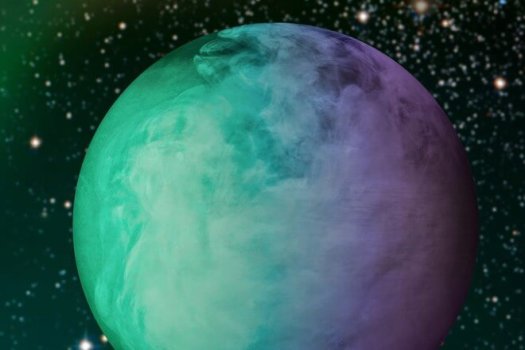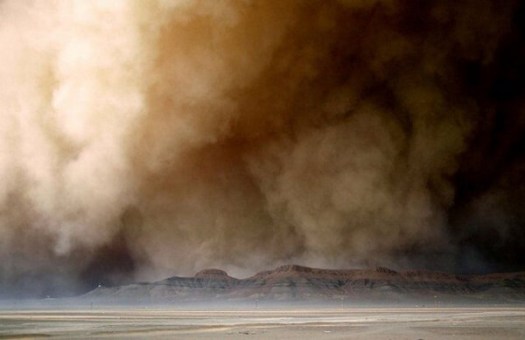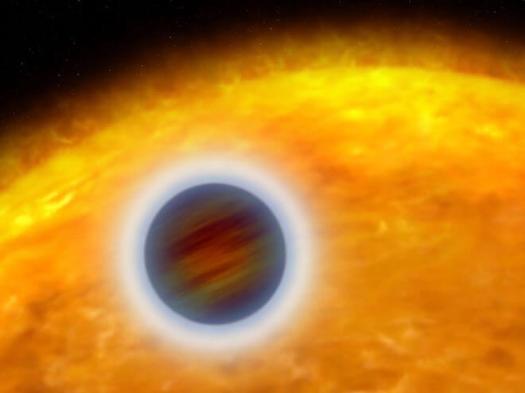
From an Earth-centric point of view, rain of course means falling water. We can have storms with falling dust — I experienced a few of those while a reporter in India — but rain is pretty much exclusively H2O falling from the clouds. But as the study of exoplanets moves aggressively into the realm of characterizing these distant planets after they are detected, the concepts of rain and clouds are changing rapidly.
We already know that it rains methane on the moon Titan, sulfuric acid on Venus and ammonia, helium and, yes, water, on Jupiter and Saturn. Some have even posited that carbon — in the form of graphite and then diamonds — falls from the “clouds” of Saturn and Jupiter, but the eye-catching view is widely disputed.
Now the clouds of exoplanets large and small are being rigorously scrutinized not only because they can potentially tell researchers a great deal about the planets below, but also because especially thick clouds have become a major impediment to learning what many exoplanet atmospheres and even surfaces are made of. Current telescopes and spectrometers just can’t see much through many of the thick ones.
Here’s why: The chemical compositions of many exo-planetary clouds are so profoundly different from what is found in our solar system. Hot gas exoplanets, for instance, tend to have clouds of irons and silicates — compounds that are in a gas form on the surface (such as it is), then rise into the atmospheres and form into grain-like solids when they get higher and colder. For some smaller exoplanets, the composition tends to be salts such as zinc sulfide and potassium chloride.
The process of identifying the make-up of different clouds is very much a work in progress, as is an understanding of how thick or how patchy the clouds may be.

On this question of exoplanet cloud cover, scientists at the University of Arizona have just published results from the first ever direct evidence of patchy clouds surrounding a directly-imaged “super-Jupiter” planet — a technical and observational step forward of some significant importance. They did it by using the Hubble Space Telescope to detect varying brightnesses in the atmosphere around the planet, signs that the cloud cover was patchy rather than blanketing the planet.
“The images showed that the brightness changes, and that means the clouds don’t cover the whole atmosphere,” said team leader Daniel Apai. ” We can see that as the planet rotates, it becomes less bright when the clouds face forward and more bright when they do not. The clouds have structure, like on Earth.”
The first author on the paper published in The Astrophysical Journal, Yifan Zhou, said that the planet, four times the mass of Jupiter, is far from its host star (or actually, it’s a failed star known as a brown dwarf.) As a result, the researchers could separate the light emitted by the planet and that from the host and measure brightness changes with precision. The observation covered almost a full rotation of the planet and found that this super-Jupiter rotates in about 10 hours.

The planet is young (10 million years) and still has an atmosphere hot enough to have “rain” clouds made of vaporized sand; silicates that are turned into gases, rise and then cool down to form tiny particles similar in size to what is found in cigarette smoke. Deeper into the atmosphere, iron droplets are forming and falling like rain, eventually evaporating as they enter the lower levels of the atmosphere.
“This rain is similar to what you might see at the Grand Canyon — it rains on top but evaporates on the way down,” Apai said. “Here we have iron and silicate clouds but in principle they are not that different from our rain clouds. Still, we have a lot to learn about how they form, why some form into multiple layers and some do not, and how they evolve.”
And how astronomers might be able to better pierce through them.
This cloud problem is related but different from the one faced by researchers trying to read the chemical compositions of exoplanet atmospheres using transit spectroscopy. For them, not only clouds but layers of dusty soot often block the light passing through the atmospheres and picking up signatures of what compounds are present.
Mark Marley, a research scientists at NASA’s Ames Research Center and a co-author on the paper, has been studying clouds on Earth and beyond for years, and knows the challenges they pose– especially since they appear to be everywhere in the cosmos where there’s an atmosphere.
“Clouds are just hard, and they’re a big deal. We worry that with in future observations clouds will limit how much we learn about the most interesting world. We’ll be looking for oxygen or water or life and clouds could very well block our view. A planet could be perfectly habitable, and we wouldn’t know it.”

Add to the likelihood that many exoplanets will be blanketed with the clouds is that cloud formation and behavior on Earth itself is incompletely understood. Marley said that the biggest source of uncertainty in weather forecasting is the dynamics of clouds.
Clouds are also the often cursed bane of astronomers. On Earth they can add greatly to the difficulty of seeing out through our atmosphere, and then light years away the difficulty of seeing into the inner atmospheres of exoplanets.
But not all is bleak. Marley said that he tells astronomers that there’s a lot to be learned about exoplanet compositions by studying even the thick layers of blanketing clouds. And instruments that will soon be available will be potentially much better at seeing through the exoplanet coverings.
Apai (and others) are looking especially to the James Webb Space Telescope when it launches in 2018 to pierce far better through clouds. Its mirrors that see in the infrared will add a potential breakthrough capability, he said, allowing for deeper and far more extensive looks into exoplanet atmospheres.
In the conclusion to their paper, Apai and his colleagues predict “that Webb will help astronomers better determine the exoplanet’s atmospheric composition and derive detailed maps from brightness changes with the new technique demonstrated with the Hubble observations.”
Improvements for sure, but still a long way to go in terms of coming to terms with those clouds of silicate sands, iron, sulfuric acid, exotic salts and everything else that exoplanets send up into the sky and then rain back down to their surfaces and interiors.

